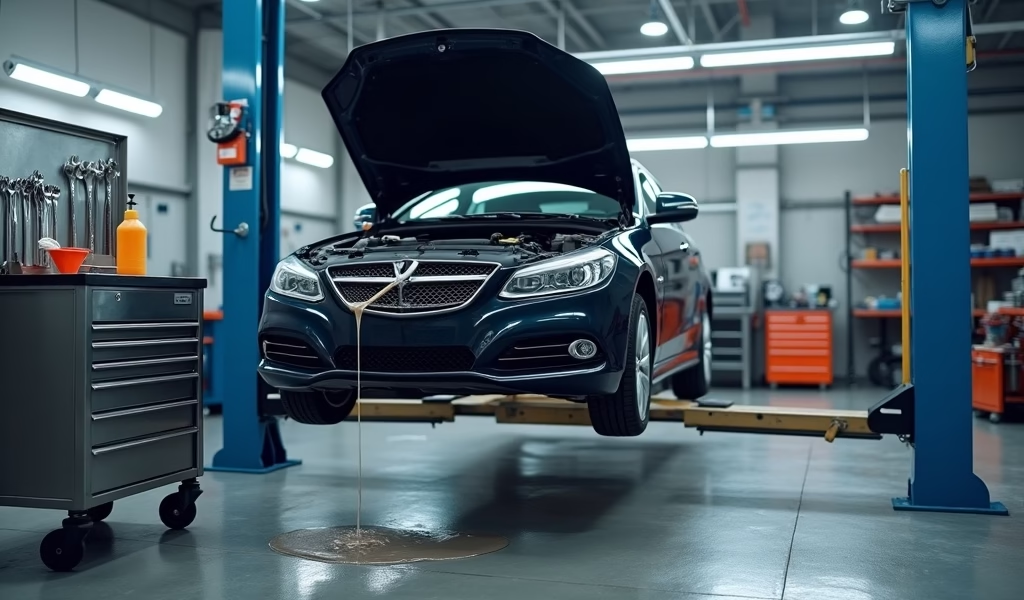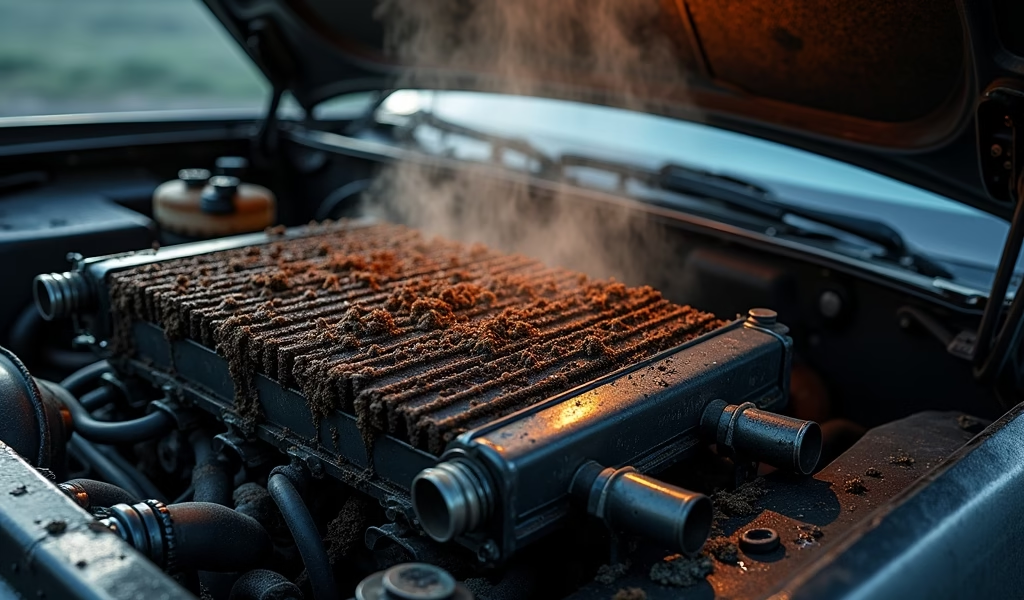Overview
This step-by-step guide explains how to unclog a car radiator through a five-stage process: preparing tools, draining old coolant, flushing the system, using chemical cleaners for stubborn clogs, and refilling with fresh coolant. The article emphasizes preventative maintenance to avoid future clogs and includes troubleshooting advice for common cooling system issues.
Table of Contents
- Understanding Radiator Clogs: Why They Happen and Signs to Watch For
- Step 1: Gather Your Tools and Prepare Your Vehicle
- Step 2: Drain the Old Coolant
- Step 3: Flush the Cooling System
- Step 4: Use a Chemical Cleaner for Stubborn Clogs
- Step 5: Refill with Fresh Coolant and Test
- Preventative Maintenance: Keeping Your Radiator Clean
- Conclusion
- Frequently Asked Questions
Understanding Radiator Clogs: Why They Happen and Signs to Watch For
Your car’s radiator is essentially the heart of your cooling system. When it gets clogged, it’s like your vehicle is having cardiovascular issues—not immediately fatal, but definitely heading toward serious trouble if left untreated.
I’ve been working on engines for over 20 years, and I can tell you that radiator clogs are among the most common yet overlooked issues that lead to expensive repairs. Most folks only realize there’s a problem when their temperature gauge hits the red zone, but by then, you’re already in hot water (sometimes literally).
Radiators typically clog due to three main culprits: mineral deposits from hard water in the coolant, rust particles from internal corrosion, or external debris that somehow found its way into your cooling system. Over time, these materials accumulate in the narrow passages of your radiator, restricting coolant flow and reducing heat transfer efficiency.
How can you tell if your radiator needs unclogging? Watch for these telltale signs:
- Engine temperature runs higher than normal, especially in slow traffic
- Sweet-smelling leaks under the vehicle (that’s coolant, folks)
- Heater blowing lukewarm air when it should be hot
- Visible rust or sediment in the coolant reservoir
- Radiator feels hot in some spots and cool in others (indicates blockage)
If you’ve noticed any of these symptoms, don’t panic—you’ve caught it in time. Learning how proper tune-up service works can prevent these issues, but today we’ll focus on solving your immediate radiator problem. With some basic tools, a free afternoon, and this guide, you’ll be able to clear that clog and get your cooling system back to peak performance.
Step 1: Gather Your Tools and Prepare Your Vehicle
Before diving into radiator work, let’s make sure you’re properly equipped. Nothing worse than getting halfway through a job only to realize you’re missing something crucial. Trust me, I’ve been there—covered in coolant with no shop towels in sight!
Here’s what you’ll need for a successful radiator unclogging operation:
- Safety glasses and chemical-resistant gloves (coolant is toxic and irritating)
- Large drain pan (at least 2 gallons capacity)
- Basic hand tools (screwdrivers, pliers, wrench set)
- Several gallons of distilled water
- Fresh coolant appropriate for your vehicle
- Radiator flush chemical cleaner
- Funnel with a wide mouth
- Shop towels or rags
- Optional: garden hose with adapter for backflushing
Now that you’ve assembled your toolkit, let’s prepare your vehicle:
First and foremost—make sure your engine is COMPLETELY COOL. I can’t stress this enough. Working on a hot radiator can result in serious burns from pressurized, scalding coolant. Park your car on level ground and wait at least 2 hours after operation before starting work.
While waiting, check your owner’s manual to locate the radiator drain plug (usually at the bottom corner of the radiator) and identify the type of coolant your vehicle requires. Different engines use different coolant formulations, and mixing types can create a chemical mess that does more harm than good.
Place cardboard or a tarp under your work area to protect against coolant spills. Not only is coolant messy, but it’s also highly toxic to pets and wildlife, so containing it is both convenient and responsible.

Step 2: Drain the Old Coolant
Now that everything’s ready, let’s get that old, contaminated coolant out of there. This step is crucial—we need to remove as much of the clog-causing material as possible before flushing.
Position your drain pan directly beneath the radiator drain plug. The placement needs to be precise since coolant will start flowing immediately when opened, and it tends to splash in unpredictable directions. I’ve ruined more than one pair of boots learning this lesson!
Locate the drain petcock (a small valve at the bottom of the radiator) and slowly open it using pliers or the appropriate wrench. If your radiator doesn’t have a drain valve, you’ll need to disconnect the lower radiator hose instead—just be prepared for a faster flow.
While the coolant drains, remove the radiator cap to speed up the process by eliminating vacuum pressure. This is also a good time to inspect the cap’s seal and spring for damage. A faulty radiator cap can cause cooling system pressure problems, leading to overheating even after you’ve cleared the clog.
Pay attention to what comes out. The color and consistency of your old coolant tell an important story:
- Clear green/orange/pink fluid with minimal particles? Your clog might be minor
- Rusty brown liquid? You’ve got corrosion issues in your system
- Sludgy, thick coolant with visible particles? That’s a major clog situation
Let the system drain completely—this typically takes 10-15 minutes. While waiting, check the condition of visible radiator fins and the radiator core for external debris or damage that might be contributing to overheating issues.
Once drained, close the drain valve or reattach the lower hose. Properly dispose of the old coolant at your local auto parts store or recycling center. Never pour coolant down a household drain or onto the ground—it’s illegal in most places and harmful to the environment.
Step 3: Flush the Cooling System
With the old coolant gone, it’s time for the main event—flushing out those nasty deposits. This step is where the real clog-busting happens.
First, close your drain valve if you haven’t already done so. Using your funnel, fill the radiator with distilled water until it’s nearly full. Why distilled? Tap water contains minerals that can contribute to future clogs—exactly what we’re trying to avoid.
Replace the radiator cap, start the engine, and let it run until it reaches normal operating temperature (usually when the cooling fan kicks on). This warm-water circulation helps loosen debris throughout the entire system. While the engine runs, turn your heater to maximum heat—this ensures the water flows through your heater core too, which can harbor hidden clogs.
After about 10-15 minutes of running, shut off the engine and let everything cool down again. I know waiting is the hardest part, but rushing this step can result in burns or incomplete flushing. Use this time to research proper coolant disposal methods for your specific area.
Once cool, drain this first batch of flush water as you did with the coolant in Step 2. You’ll likely see additional dirt, rust, and debris coming out—that’s a good thing! It means our flush is doing its job.
For severely clogged systems, you may want to perform what we call a “backflush.” This involves connecting a garden hose to various points in the system and forcing water through in the opposite direction of normal flow. If you’re comfortable doing this, disconnect the upper and lower radiator hoses and flush water through them individually. Just be sure not to use excessive water pressure that could damage delicate radiator tubes.
Repeat the fill-run-drain process at least twice more, or until the drained water runs relatively clear. Each flush removes more contaminants, gradually restoring your radiator’s flow capacity.
Step 4: Use a Chemical Cleaner for Stubborn Clogs
If your radiator was severely clogged, or if you still see discoloration after several water flushes, it’s time to bring in the big guns—chemical radiator cleaners. These specialized formulas dissolve stubborn deposits that water alone can’t remove.
Choose a quality radiator flush product from your local auto parts store. I typically recommend products from established brands like Prestone, BlueDevil, or Thermocure. The few extra dollars for premium products are worth it when your engine’s health is on the line.
With your system drained from the previous step, it’s time to add the chemical cleaner:
- Pour the recommended amount of cleaner into your radiator (follow the product instructions precisely)
- Fill the remainder of the system with distilled water
- Replace the radiator cap
- Start the engine and run it until it reaches normal operating temperature
- Turn your heater to maximum to circulate the cleaner through the entire system
Let the engine run for the duration specified on the product label—usually between 10-30 minutes. During this time, the chemicals are working to dissolve minerals, rust, and other deposits throughout your cooling system. It’s a bit like descaling a coffee maker, but for your car.
I’ve seen chemical cleaners work miracles on systems I thought were beyond saving. In one memorable case, a customer’s truck was overheating so badly it couldn’t make it up a hill, but after a thorough chemical flush, it ran cool as a cucumber through the entire summer.
After the specified time, turn off the engine and allow it to cool completely before draining the chemical solution. This cooldown period gives the cleaner additional time to break down stubborn deposits.
Once cool, drain the chemical solution as you did in previous steps. The liquid that comes out might look alarming—often dark or rusty with floating particles. This is normal and actually indicates the cleaner is doing its job effectively.
After draining the chemical solution, you must flush the system with clean distilled water at least twice to remove all traces of the cleaning chemicals. Chemical cleaners are effective at removing clogs but can damage your cooling system if left inside.

Step 5: Refill with Fresh Coolant and Test
You’ve done the hard work of cleaning out your radiator system, and now it’s time for the final step—refilling with fresh coolant and ensuring everything works properly.
First, double-check that all drain plugs are tight and hose connections are secure. Nothing ruins your day faster than watching fresh coolant pour onto your driveway because of a loose connection!
Prepare your coolant mixture according to your vehicle specifications. Most vehicles use a 50/50 mix of antifreeze and distilled water, though some modern vehicles require pre-mixed coolant or different ratios. Check your owner’s manual or consult manufacturer guidelines if you’re unsure.
Using your funnel, slowly pour the coolant mixture into the radiator or reservoir until it reaches the “full” line. Take your time with this step—pouring too quickly can trap air in the system, creating air pockets that prevent proper cooling.
Here’s where many DIYers make a critical mistake—they forget to “burp” the cooling system to remove trapped air. Here’s how to do it right:
- Fill the radiator to about an inch below the neck
- Start the engine with the radiator cap off
- Set your heater to maximum heat
- Rev the engine gently to about 1500-2000 RPM for several minutes
- Watch for bubbles in the radiator opening—this is trapped air escaping
- Add coolant as needed to maintain level as air escapes
- Once bubbling stops and the coolant level stabilizes, replace the cap
Some modern vehicles have specific bleeding procedures or bleeder valves that make this process easier. If your vehicle has these features, follow the manufacturer’s recommended procedure.
With the system filled and bled, it’s time to test your handiwork. Take your vehicle for a short drive, monitoring the temperature gauge closely. The needle should stay in the normal range, even when idling for extended periods.
After your test drive, let the vehicle cool completely and then check the coolant level again. It’s normal to need a small top-up after the initial fill as air continues to work its way out of the system.
Also check under your vehicle for any signs of leaks—sometimes the process of removing and reinstalling hoses can disturb seals or connections that were borderline to begin with.
Preventative Maintenance: Keeping Your Radiator Clean
Now that you’ve gone through the effort of unclogging your radiator, let’s talk about keeping it that way. An ounce of prevention is worth a pound of radiator repairs—trust me on this one.
First and foremost, establish a regular coolant exchange schedule. For most vehicles, changing your coolant every 30,000 miles or 2 years (whichever comes first) prevents the buildup that leads to clogs. Modern long-life coolants may extend this interval, but I still recommend at least checking it at these intervals.
Use only the correct type of coolant for your vehicle. Mixing coolant types can cause chemical reactions that create deposits and accelerate corrosion. That bargain-bin universal coolant might save you a few bucks today but cost hundreds down the road.
Keep your cooling system sealed properly. A failing radiator cap, loose hose clamp, or deteriorating gasket allows air to enter the system, which increases corrosion rates dramatically. These small parts are inexpensive to replace during regular maintenance.
Consider adding a quality coolant filter to your system if you frequently encounter cooling issues. These inline filters catch debris before it can accumulate in your radiator. They’re especially useful for older vehicles or those operated in dusty environments.
Regularly inspect the outside of your radiator for debris and damage. Leaves, bugs, and road grime can block airflow through the fins, reducing cooling efficiency even when the internal passages are clear. A gentle rinse with a garden hose (engine off and cool) can remove these external blockages.
Pay attention to your vehicle’s temperature gauge during normal driving. Catching small temperature fluctuations early can alert you to developing issues before they become major problems. As noted by safety experts at NHTSA, maintaining proper engine temperature is also critical for safety systems to function correctly.
Conclusion
Congratulations! You’ve now mastered the essential skill of unclogging a car radiator. What might have cost you $200-300 at a shop, you’ve handled with some basic tools and a few hours of your time. More importantly, you’ve gained firsthand knowledge of how your vehicle’s cooling system works.
Remember that a clear radiator is crucial for your engine’s health and longevity. By following the five steps we’ve covered—preparing properly, draining the old coolant, flushing thoroughly, using chemical cleaners when necessary, and carefully refilling the system—you’ve potentially added years to your vehicle’s life.
Of course, there are situations where DIY methods might not be enough. If you’ve completed these steps and your vehicle still runs hot, or if you discovered damaged components during the process, it might be time to consult a professional mechanic. Some severely clogged systems may require radiator removal for bench cleaning or even replacement.
But for most vehicles suffering from normal buildup and minor clogs, the process we’ve outlined today will restore proper cooling function and help prevent those dreaded roadside overheating emergencies. Your engine will thank you with reliable service and improved performance.
Keep those radiator passages clear, and you’ll be cruising cool for many miles to come!
Frequently Asked Questions
How often should I unclog my car radiator?
Most vehicles benefit from a radiator flush every 30,000 miles or 2 years, whichever comes first. If you notice overheating or cooling performance issues before then, don’t wait—address it immediately.
Can I use tap water instead of distilled water when flushing my radiator?
While tap water will work for the flushing process, always use distilled water for the final fill with coolant. Tap water contains minerals that can contribute to future radiator clogs and scaling.
What’s the difference between flushing and unclogging a radiator?
Flushing is a preventative maintenance procedure that removes old coolant and minor deposits. Unclogging is a more thorough process targeting existing blockages, often requiring chemical cleaners and multiple flushes.
Is it safe to drive with a clogged radiator?
No, driving with a clogged radiator risks severe engine damage from overheating. If your temperature gauge shows higher than normal readings, address the issue before driving the vehicle further.
Can I unclog my radiator without removing it from the vehicle?
Yes, most radiator clogs can be cleared using the flush method described in this article without removing the radiator. Severe clogs or physical damage may require radiator removal or replacement.

